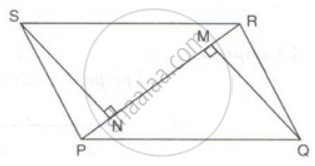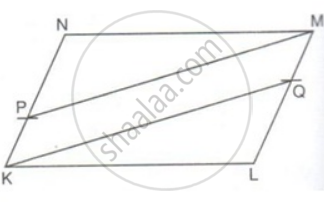Advertisements
Advertisements
Question
SN and QM are perpendiculars to the diagonal PR of parallelogram PQRS.
Prove that:
(i) ΔSNR ≅ ΔQMP
(ii) SN = QM
Solution
(i) In ΔSNR and ΔQMP
∠SNR = ∠QMP ...(right angles)
∠SRN = ∠MPQ ...(alternate angles since PQ || SR0
∴ ΔSNR ∼ ΔQMP
∠RSN = ∠PQM .........(i)
In ΔSNR and ΔQMP
∠SRN = ∠MPQ
∠RSN = ∠PQM ...(from (i))
PQ = SR ...(PQRS is a parallelogram)
Therefore, ΔSNR ≅ ΔQMP ...(ASA axiom)
(ii) Since ΔSNR ≅ ΔQMP
Hence, SN = QM.
APPEARS IN
RELATED QUESTIONS
ABCD is a parallelogram. P and T are points on AB and DC respectively and AP = CT. Prove that PT and BD bisect each other.
ABCD is a rectangle with ∠ADB = 55°, calculate ∠ABD.
Prove that if the diagonals of a parallelogram are equal then it is a rectangle.
P is a point on side KN of a parallelogram KLMN such that KP : PN is 1 : 2. Q is a point on side LM such that LQ : MQ is 2 : 1. Prove that KQMP is a parallelogram.
Prove that the line segment joining the mid-points of the diagonals of a trapezium is parallel to each of the parallel sides, and is equal to half the difference of these sides.
In a parallelogram PQRS, M and N are the midpoints of the opposite sides PQ and RS respectively. Prove that
MN bisects QS.
Prove that the diagonals of a kite intersect each other at right angles.
The diagonals AC and BC of a quadrilateral ABCD intersect at O. Prove that if BO = OD, then areas of ΔABC an ΔADC area equal.
In the given figure, PQ ∥ SR ∥ MN, PS ∥ QM and SM ∥ PN. Prove that: ar. (SMNT) = ar. (PQRS).
In ΔABC, the mid-points of AB, BC and AC are P, Q and R respectively. Prove that BQRP is a parallelogram and that its area is half of ΔABC.
